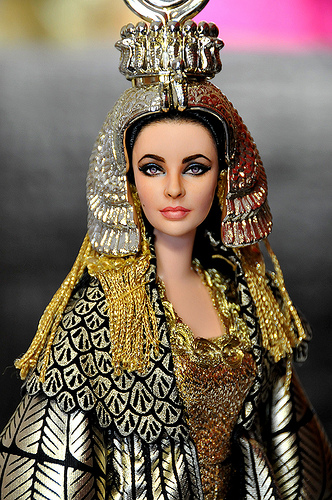“I will not be triumphed over.” – Cleopatra VII Philopator
- Cleopatra VII Philopator was the second last pharaoh of Ancient Egypt, in Africa, but often regarded as the last, due to her son’s short reign before he was killed 11 days after the death of his mother.
- ‘Cleopatra VII Philopator’ is also known simply as ‘Cleopatra’, and her name comes from the Geek word ‘Kleopatra’, meaning ‘glory of the father’.
- Cleopatra VII Philopator was born in Egypt’s Alexandria, in 69 BC, and her father was Ptolemy XII Auletes, and her mother was possibly Cleopatra V Tryphaena, although this is uncertain.
- Cleopatra VII Philopator first ruled at 18 years of age, along with her 10 year old brother Ptolemy XIII, whom she quickly excluded from official responsibilities and with whom she fell out of favour.
- Unlike the rest of her family and predecessors who spoke Greek, Cleopatra VII Philopator also learnt Egyptian, and is believed to have known six to nine languages in all.
A depiction of Cleopatra
Image courtesy of Noel Cruz/Flickr
- Along with Julius Caesar of Ancient Rome, Cleopatra VII Philopator launched an attack on her brother, then Pharaoh of Egypt, to regain Egyptian reign.
- Cleopatra VII Philopator was officially married to her younger brother, and had an eldest son with Julius Caesar, and after Caesar’s death she married Mark Antony, also from Ancient Rome, with whom she had three more children.
- According to ancient texts, Cleopatra VII Philopator was considered very beautiful, and very intelligent, although her beauty may have come from her charm rather than her looks, but whatever the case, she was said to be influential among males.
- Cleopatra VII Philopator committed suicide on 12 August, 30 BC, most likely by asp (venomous snake) bite, after the successful conquest of the Roman enemy, Octavian.
- Cleopatra VII Philopator is depicted in many artworks, film media, and literature, and most notably in the Shakespearean play ‘Antony and Cleopatra’.
Bibliography:
Cleopatra, 2014, Wikipedia, http://en.wikipedia.org/wiki/Cleopatra
Cleopatra: the woman behind the name, 2013, Tour Egypt, http://www.touregypt.net/cleopatr.htm







I have read few books about cleopatra.Then,i came to the conclusion that she was a beautiful and small figured lady from southern part of Asia.In history migrations had happened many years ago.